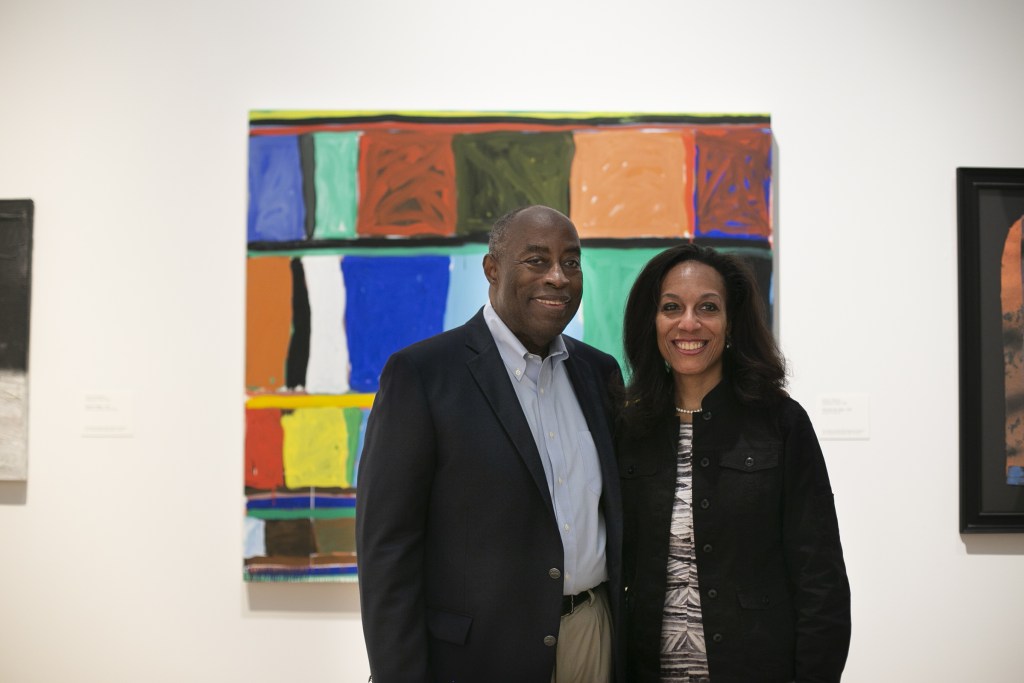
by VICTORIA L. VALENTINE on Jun 11, 2020 • 2:58 am
AN AVID COLLECTOR of African American art and generous museum patron, Ronald Ollie (1951-2020) has died. He passed away following a fall at his home in Newark, N.J., on June 1. He was 69. His wife Monique McRipley Ollie confirmed his death to Culture Type. She told me via email, “I think his most powerful legacy is his lasting relationships with his family and friends. His love and generous spirit will remain with all who were blessed to have known him.”
A retired mechanical engineer, Ollie began purchasing art in the late 1980s. Partial to abstraction, he amassed a collection of more than 200 works. He wasn’t just buying art. He took pride in forming longstanding friendships with the artists whose works he collected, including James Little, Ed Clark, and Herbert Gentry, a mentor who early on helped guide his acquisitions.
Ollie and Little met nearly three decades ago and became close friends. “Ron was a person of character, passion, and generosity,” Little told me. Over the years, the collector came to own five works by the artist.
“I had no idea that he would become the quintessential collector that he became,” Little said. “I got to know him better and what stood out to me was his interest only in abstract art by African American artists. I found that to be rare.”
In 2017, the Ollies donated 81 works by 33 artists to the Saint Louis Art Museum (SLAM). Works by Little, Gentry, Clark, Terry Adkins, Chakaia Booker, Frank Bowling, Sam Gilliam, Norman Lewis, Mary Lovelace O’Neal, Al Loving, Stanley Whitney, Jack Whitten, Frank Wimberley, and William T. Williams, are represented in the gift, which also includes photographs by Frank Stewart, Hugh Bell, Adger Cowans, and Leroy Henderson, as well as works by Jacob Lawrence and Benny Andrews, artists known for figuration.
Longtime residents of Newark, the couple chose the institution because Ollie grew up in St. Louis and, along with his three siblings, was first exposed to art visiting the museum with his mother and father. The experience had a lifelong influence. When he considered a permanent home for the Thelma and Bert Ollie Memorial Collection, named for his parents, Ollie said SLAM was his “first and only choice.”
“I think his most powerful legacy is his lasting relationships with his family and friends. His love and generous spirit will remain with all who were blessed to have known him.” — Monique Ollie
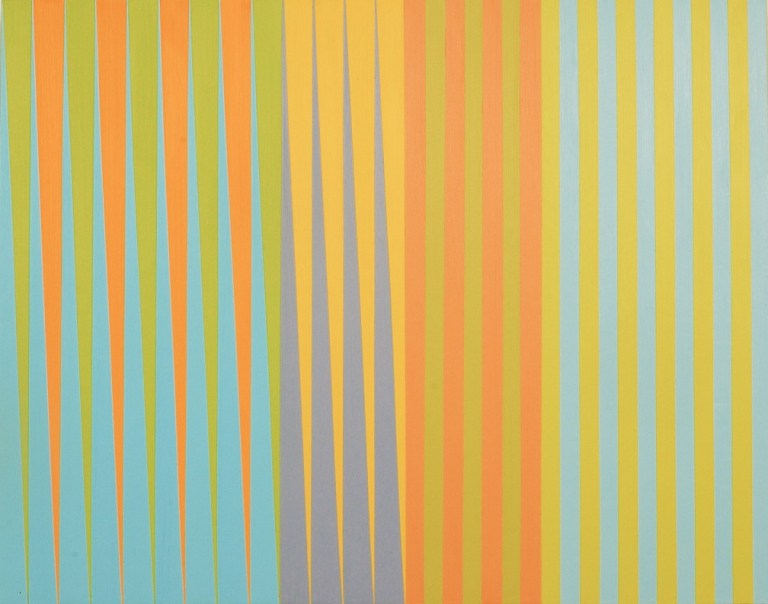
JAMES LITTLE, “Double Exposure,” 2008 (oil and wax on canvas, unframed, 39 × 50 inches). | Saint Louis Art Museum, The Thelma and Bert Ollie Memorial Collection E14521.76 © James Little
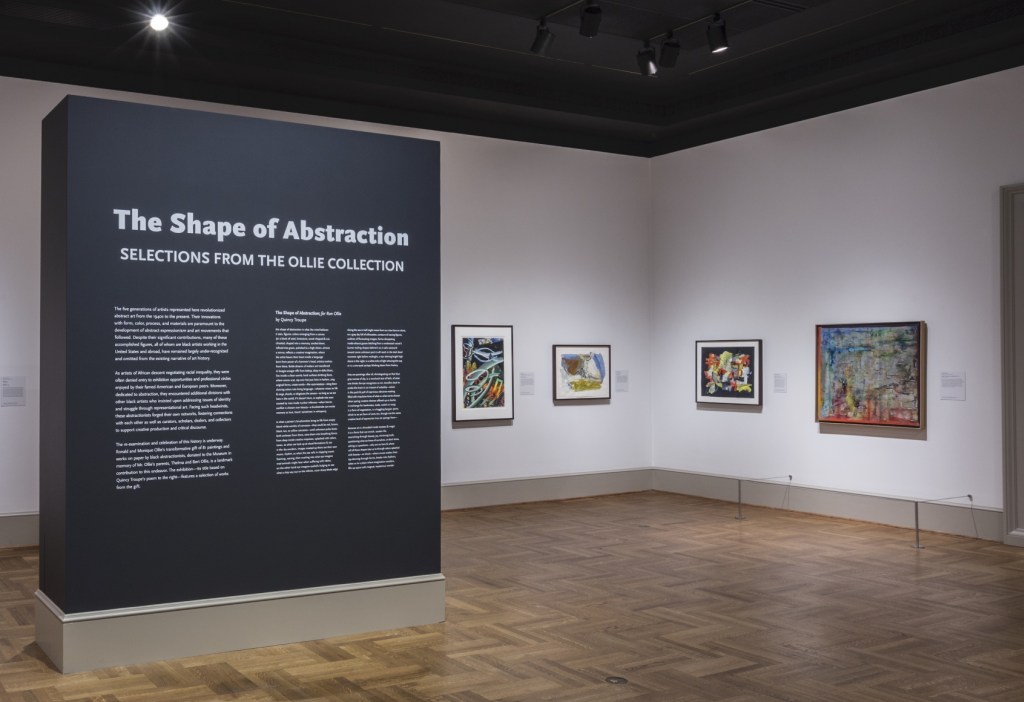
“The Shape of Abstraction: Selections From the Ollie Collection” features works gifted to the Saint Louis Art Museum by Ronald and Monique Ollie. When the museum re-opens on June 16, the exhibition will remain on view through Oct. 11, 2020. | Courtesy Saint Louis Art Museum
THE SAINT LOUIS ART MUSEUM opened an exhibition dedicated to the works in September 2019. Originally slated to conclude March 22, the run of “The Shape of Abstraction: Selections From the Ollie Collection” was cut short when the museum closed temporarily on March 16 due to COVID-19. SLAM is reopening June 16 and has extended the exhibition through Oct. 11. It’s a bittersweet moment given Ollie’s death, but a profound testament to the collector’s legacy.
“I never started out to be a collector, but I loved art. And I wanted to have art on the wall. I always loved having pictures on the wall. And so, I started out buying one piece, another piece, and I was dabbling into it,” Ollie said in a video about the exhibition.
“Abstraction was my reason and my love and my passion for art and that’s why I collected it. I was able to connect up with some of those black artists that were part of a movement like Abstract Expressionism. We developed close relationships and close ties.”
“Abstraction was my reason and my love and my passion for art and that’s why I collected it. I was able to connect up with some of those black artists that were part of a movement like Abstract Expressionism. We developed close relationships and close ties.” — Ronald Ollie
In addition to their gift of art, the Ollies established the Ronald M. and Monique M. Ollie Education Endowment Fund for Abstraction by Black Artists. The endowment provides annual support for public programming for youth, families, and students, including lectures, artist talks, performances, and research fellowships.
Ollie last visited the museum with his wife on Feb 21 to attend “Talking Abstraction: An Evening with Artists,” a panel discussion with Little, Nanette Carter, and Bill Hutson, that was supported by the Ollie endowment fund and the Trio Foundation of St. Louis. “The Shape of Abstraction” features works by all three artists.
“Ron’s passion for art, which he credited to childhood visits to the Saint Louis Art Museum in the 1950s, was an invigorating reminder to many of us of why museums exist,” SLAM Director Brent R. Benjamin said in a statement to Culture Type.
“His generosity to this museum was thoughtful and broad, encompassing both the transformative 2017 gift of art and research materials, as well as an endowment to provide support for public programming about African American abstraction. Generations of visitors will be the beneficiaries of his extraordinary legacy.”
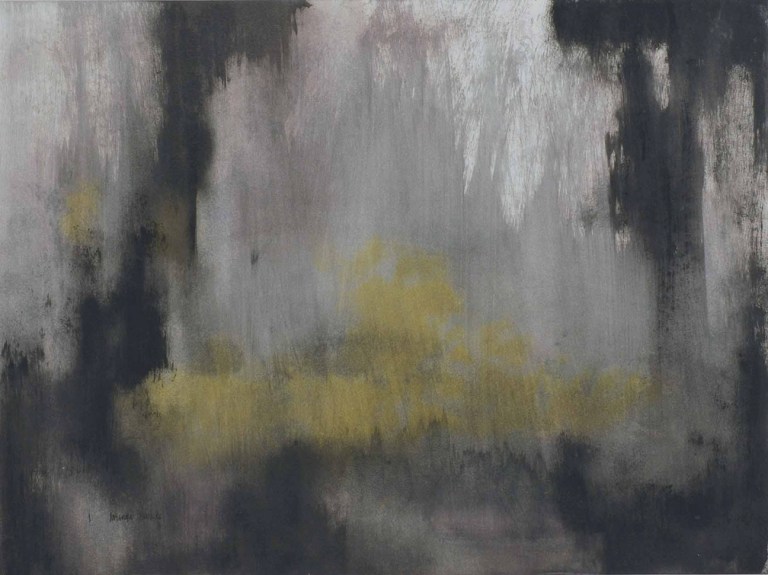
NORMAN LEWIS, “Untitled,” n.d. (work on paper, unframed, 18 × 24 inches). | Saint Louis Art Museum, The Thelma and Bert Ollie Memorial Collection E14521.53 © Estate of Norman W. Lewis; Courtesy of Michael Rosenfeld Gallery LLC, New York, NY

Ollies in galleryRonald and Monique Ollie visiting “The Shape of Abstraction: Selections From the Ollie Collection” at the Saint Louis Art Museum. | Courtesy Saint Louis Art Museum
RONALD MAURICE OLLIE was born in St. Louis, Mo., and developed a love of the arts during childhood. According to family lore, he sang before he could talk. He also had an early interest in visual art borne of his visits to the Saint Louis Art Museum and the art classes his mother enrolled him in.
His talents were also exceptional in math and science, leading him to pursue engineering in college. Ollie attended what is now the Missouri University of Science and Technology in Rolla, Mo. According to the obituary prepared by the family, Ollie joined Alpha Phil Alpha fraternity and was a civic-minded student who “advocated for broader recruitment of students of color and greater outreach in high schools and elementary schools to increase awareness in engineering as a potential career.”
Ollie earned a B.S. degree in mechanical engineering in 1973. He retired after a 30-year career in mechanical engineering and business development at major architectural and engineering firms.
Art brought the Ollies together. The couple met in 2003 at the National Black Fine Art Show in New York City and share a background in engineering. Monique is a biomedical engineer. They were married in 2004 and together have been committed to supporting and advocating for the arts.
In addition to his passion for art, Ollie is a voracious book collector. His library grew to more than 2,100 volumes on black art, history, and culture. He also collected Negro spiritual sheet music.
Over the years, Ollie served on many boards related to art, engineering, and the environment. Earlier this year, Ollie became a trustee at the Saint Louis Art Museum. He had also been a trustee of the Newark Museum of Art since 2012.
“Ron brought to our board a true passion for art and community that will be sorely missed. As a student of science, a widely respected professional in engineering, and a renowned collector of American art, Ron was the embodiment of our museum’s values. As a champion of our American Art department, Ron’s knowledge and advocacy for art helped to shape a number of our exhibitions and programs over the years,” Director Linda Harrison said in a statement to trustees of the Newark Museum of Art.
“Ron’s indefatigable belief in bringing the whole of the community into the decision-making process lives on in the work of our board and staff today. Whether it was restoring his beautiful home in the historic Forest Hills section of Newark with his wife Monique, or advocating for our Museum or our neighbor non-profit Newark School of the Arts, Ron showed a love for our city that will be part of his lasting legacy.”
“Ron brought to our board a true passion for art and community that will be sorely missed… Ron’s knowledge and advocacy for art helped to shape a number of our exhibitions and programs over the years… [His] indefatigable belief in bringing the whole of the community into the decision-making process lives on in the work of our board and staff today.” — Newark Museum of Art Director Linda Harrison
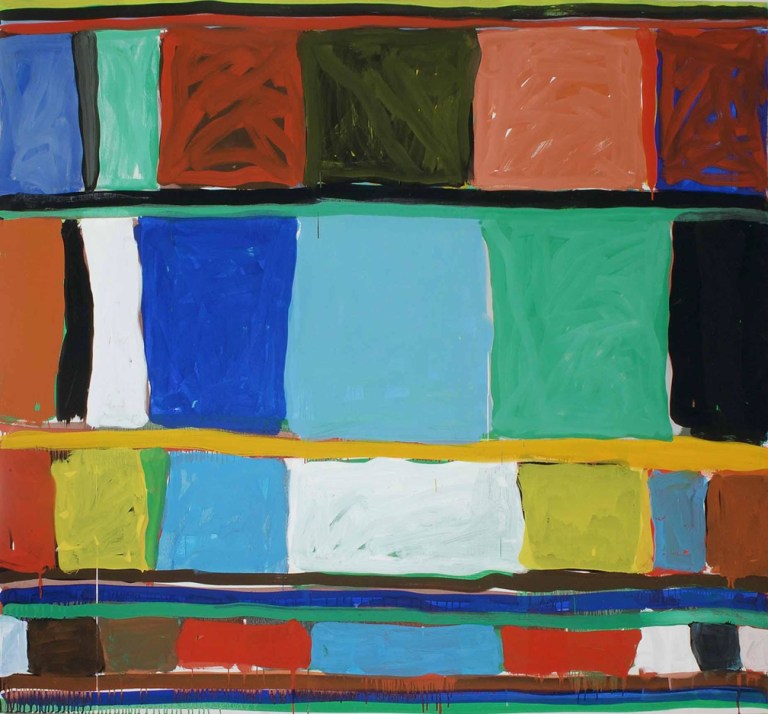
STANLEY WHITNEY, “Out into the Open,” 1992 (unframed, acrylic on canvas, 53.5 × 60 inches). | Saint Louis Art Museum, The Thelma and Bert Ollie Memorial Collection. E14521.79 © Stanley Whitney
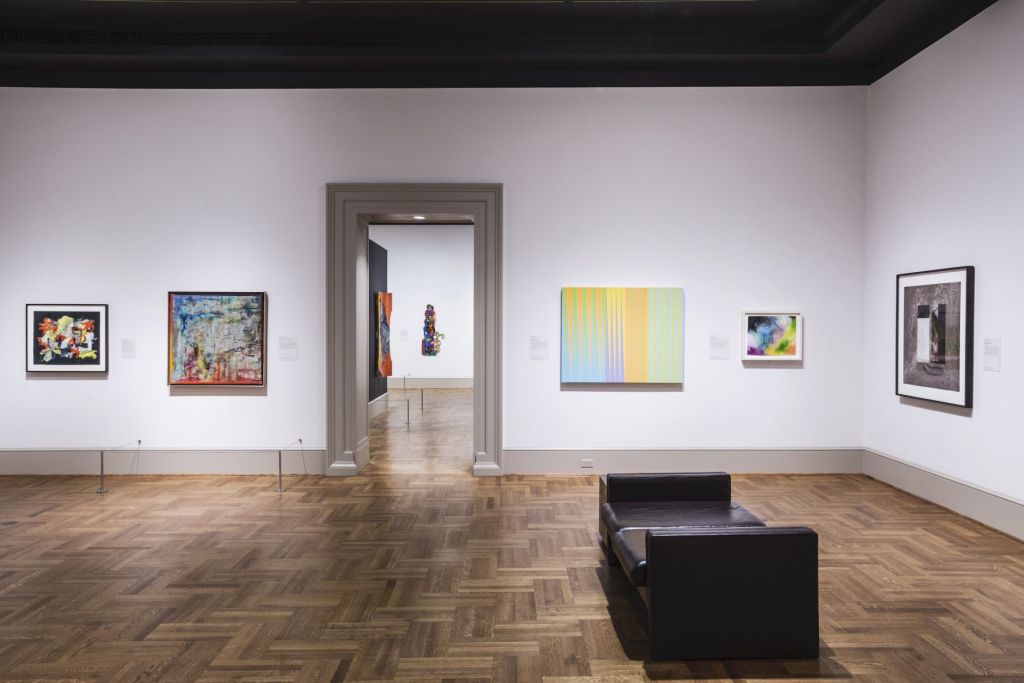
Installation view of “The Shape of Abstraction: Selections From the Ollie Collection” at the Saint Louis Art Museum. | Courtesy Saint Louis Art Museum
AS JAMES LITTLE NOTED EARLIER, Ollie’s penchant for abstract art was rare. When he began buying, African American collectors primarily sought representational images that directly explored black subjectivity and the black experience through figuration, which is what most black artists were producing.
Through the Civil Rights and Black Power Movements, a time when matters of race and rights were dominating the national discourse, African American artists were considering the best way to express themselves and make aesthetically complex work.
Following this culturally transformational period, Ollie began collecting in the late 1980s. Decades after Alma Thomas and Norman Lewis were active, it was still a political decision to pursue abstraction. The artists that did, found few collectors who understood their work and were willing to buy it.
This of course was years before interest in art by African American artists extended meaningfully beyond African American collectors. Today, while an attention gap persists, a spectrum of black artists living and dead are receiving notable mainstream recognition, including Lewis, Clark and Jack Whitten—masters of abstraction represented in the Ollie collection.
In 2010, in advance of the opening of the National Museum of African American History and Culture in Washington, D.C., the Ollies donated “Ceremony” (1993), a painting by Gentry, to the Smithsonian museum.
In 2017, the Ollies made the gift to SLAM. Their largesse includes art; an archive of related books, ephemera, and other research materials; and additional endowed support for programming.
In 2018, The New York Times visited the Ollies at home to talk about their art collection for a feature called Show Us Your Wall. During the interview Ollie said when he started buying the artworks were “very affordable.” He also shared his experiences interacting with the many artists he collected, including Frank Bowling.
“I started buying directly from the artists, and I could negotiate with them. Ed Clark would take me to various studios, like Stanley Whitney’s or Frank Bowling’s,” Ollie told the Times. “I was going to buy a piece, and Frank said, ‘I’m going to give you my landlord’s address and I want you to pay the rent every month.’ I didn’t have to pay the painting all right off and I was helping him pay his rent in Dumbo.”
“I started buying directly from the artists, and I could negotiate with them. Ed Clark would take me to various studios, like Stanley Whitney’s or Frank Bowling’s.” — Ronald Ollie
Little met Ollie nearly 30 years ago at an exhibition hosted by Syracuse University at Cinque Gallery, the now-shuttered New York City space established by Romare Bearden, Norman Lewis, and Ernest Crichlow. (Little earned an MFA from Syracuse in 1976.) The three-artist show featured Little, Ed Clark, and Renee Cox.
Ollie asked if he could visit Little’s studio in Williamsburg, Brooklyn. When he stopped by, the collector purchased one work and subsequently, over the years, acquired four more from Little.
“Ron and I became very close friends, and one of his famous quotes to me about his approach to collecting art was, ‘No matter how much I like the art, I equally have to know and like the artist,’” Little said.
“We spoke two or three times a week until his death. Ron was a brother in the true sense, and he never wavered from his commitment to black abstract artists. He never followed trends, styles, or hyperbole. He collected from his heart and his soul. We were lucky to have him and I was fortunate to know him. May he rest in peace.” CT
READ MORE about the Ollie gift to the Saint Louis Art Museum on Culture Type
FIND MORE Ronald Ollie recently spoke to The New York Times about an artist’s legal suit against a black-owned gallery
Ronald Ollie gifted 81 works of art to the St. Louis Art Museum in 2017, including 18 works by Herbert Gentry, seven by Ed Clark, six by Al Loving, and five by both Sam Gilliam and Frank Wimberley. Ollie discusses his collecting and the exhibition “The Shape of Abstraction: Selections From the Ollie Collection.” | Video by Saint Louis Art Museum
BOOKSHELF
Fully illustrated, “Ed Clark: A Survey” was published to accompany a career-spanning exhibition at Mnuchin Gallery in New York. “Ed Clark: Big Bang” documents the artist’s Tilton Gallery exhibition curated by David Hammons. Several recent volumes explore the work of Stanley Whitney, including “Stanley Whitney: In the Color” authored by Adrianna Campbell; “Stanley Whitney: Sketchbook,” and “Stanley Whitney,” published by Lisson Gallery. “Stanley Whitney: Afternoon Paintings,” a slipcased volume, is forthcoming next month. Authored by Matthew Jeffrey Abrams, who wrote about the artist for Gagosian Quarterly, “Stanley Whitney (Contemporary Painters Series)” is expected in August. “Procession: The Art of Norman Lewis” documents the first major museum retrospective of Norman Lewis organized by the Pennsylvania Academy of the Fine Arts and curated by Ruth Fine. “Herbert Gentry: The Man, The Master, The Magic,” authored by Mary Anne Rose, was published more than a decade ago by G.R. N’Namdi Gallery.